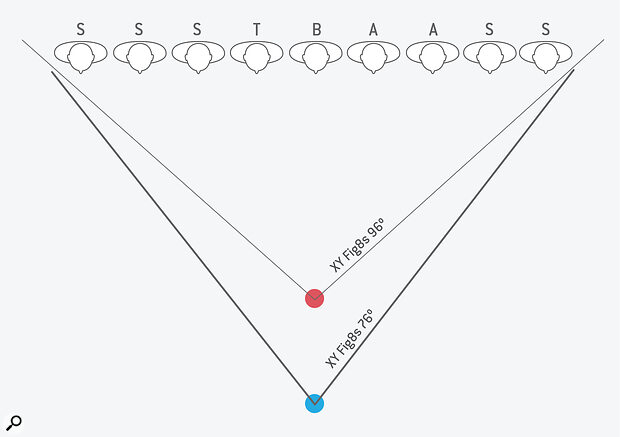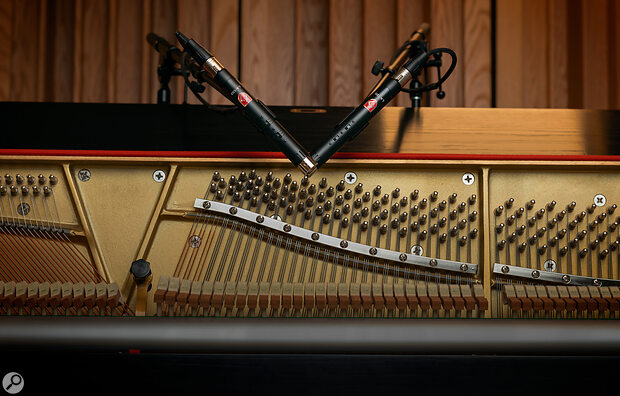This third article of our stereo mini‑series explores how to manipulate the perspective obtained from coincident mic pairs.
In Part 2, I explained how Alan Blumlein invented Intensity Stereo in the early 1930s, and that its key innovation was that differences purely in amplitude between signals, fed to two loudspeakers placed at two points of an equilateral triangle, could be converted into inter‑aural time differences (ITDs) for a listener located at the triangle’s third point. Many people argue that this concept and implementation is the true origin of stereophony, but we’ll see as this series progresses that most modern recordings push Blumlein’s theoretical boundaries quite a long way! Nevertheless, there is still more to explore in Blumlein’s Intensity Stereo idea...
We closed last month with a description of Blumlein’s initial setup, using coincident (aka X‑Y) figure‑8 microphones set with a mutual angle of 90 degrees, and I explained how that arrangement gave a Stereo Recording Angle (SRA) of about 76 degrees. You’ll hopefully remember the significance of the SRA: sound sources arranged within that 76‑degree region in front of the microphones in the recording environment are ‘mapped’ onto the 60‑degree angle between the loudspeakers in the replay environment, and their relative positions are preserved in the stereo image.
To demonstrate this microphone arrangement, I recorded a small choir using coincident figure‑8 mics set up in the Blumlein format (audio example 1 in the accompanying files: https:sosm.ag/this-is-stereo-media), with the choir arranged to almost fill a 76‑degree arc in front of the microphone. If you listen to that track on loudspeakers in a reasonably well‑treated acoustic, the choir should be spread almost fully across the sound stage, and with quite clearly focused images of each singer; hopefully, you should feel as if you could point at each individual voice. In fact, this impression of precise, focused sound positioning within the stereo image is a major strength of most coincident microphone techniques. If I were to offer a visual analogy, I’d suggest a comparison with a photorealistic painting, for example.
Perspectives
However, stereo recording is about much more than just the left‑right imaging; the perspective of sound sources is critically important too. By ‘perspective’, I mean the perceived distance or depth of each singer within the full sound stage, and the balance between direct and reverberant sound.
In example 1, the (empty) church is quite reverberant, yet the captured perspective is quite acceptable in the context of the Tallis piece I recorded. But what if we wanted a drier and closer sound? That would obviously require the microphones to be moved closer to the choir. But if we were to do that, the singers at the outer edges of the choir would be outside of the 76‑degree SRA of the Blumlein array.
The audible result depends on just how far outside the SRA the outer singers become, but at best they would appear bunched into the loudspeakers, and at worst they would be captured with opposite polarities in each channel, and thus attenuated, upsetting the balance in a mono downmix and appearing rather phasey and unfocused in stereo. In other words, the positional information within the stereo image would become distorted compared to the actual source positions in front of the microphones — a little like the optical distortion you see when a very wide‑angle camera lens is placed close to the subject.
To maintain a representative spread of singers across the full stereo image in a closer perspective, a much wider SRA will be required — this way, we can accommodate the greater stage width relative to the microphone’s closer position — and, fortunately, there are a couple of ways of achieving a wider SRA. The first is to alter the mutual angle of the microphones. For example, by angling the mics inwards (ie. reducing the mutual angle), achieving a given amplitude difference between channels (and thus establishing a specific stereo image position) requires sound sources to move further away from the centre line than before — so the SRA is increased. This gives us Rule 1, when it comes to tweaking stereo mic arrays: reducing the Mutual Angle increases the Stereo Recording Angle.
Applying this idea to our Blumlein array, if the mutual angle of the microphones is reduced to 70 degrees (instead of 90) the SRA increases to 96 degrees. That wider SRA allows the mics to be moved closer to the choir, giving a drier perspective, but with the stereo image still spread nicely between the speakers without bunching at the edges, as shown in Diagram 1. Note, though, that while in this case a 20‑degree reduction in mutual angle provides a 20‑degree increase in SRA, the proportions vary with other stereo mic arrays. For example, reducing the mutual angle of X‑Y cardioids by 20 degrees causes a 30‑degree increase to the SRA.
 Diagram 1: The wider the stereo recording angle (SRA), the closer the mics can be placed to the source. The letters above the figures on the diagram represent the singing range of each vocalist, ie. S = Soprano, T = Tenor, B = Bass and A = Alto.
Diagram 1: The wider the stereo recording angle (SRA), the closer the mics can be placed to the source. The letters above the figures on the diagram represent the singing range of each vocalist, ie. S = Soprano, T = Tenor, B = Bass and A = Alto.
Of course, there’s only so far you can realistically reduce or increase the mutual angle before other imaging and tonality...
You are reading one of the locked Subscribers-only articles from our latest 5 issues.
You've read 30% of this article for FREE, so to continue reading...
- ✅ Log in - if you have a Digital Subscription you bought from SoundOnSound.com
- ⬇️ Buy & Download this Single Article in PDF format £0.83 GBP$1.49 USD
For less than the price of a coffee, buy now and immediately download to your computer, tablet or mobile. - ⬇️ ⬇️ ⬇️ Buy & Download the FULL ISSUE PDF
Our 'full SOS magazine' for smartphone/tablet/computer. More info... - 📲 Buy a DIGITAL subscription (or 📖 📲 Print + Digital sub)
Instantly unlock ALL Premium web articles! We often release online-only content.
Visit our ShopStore.

